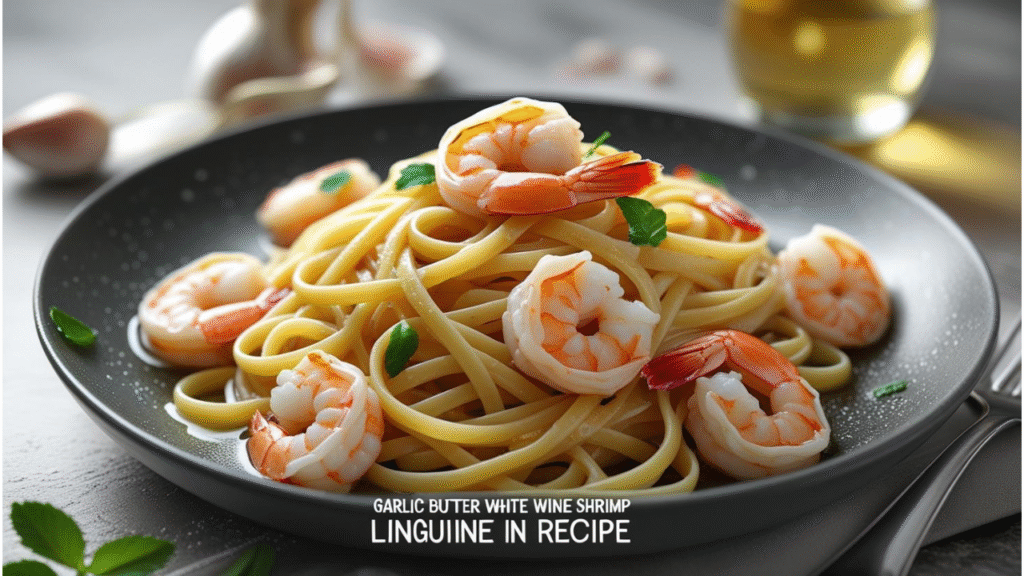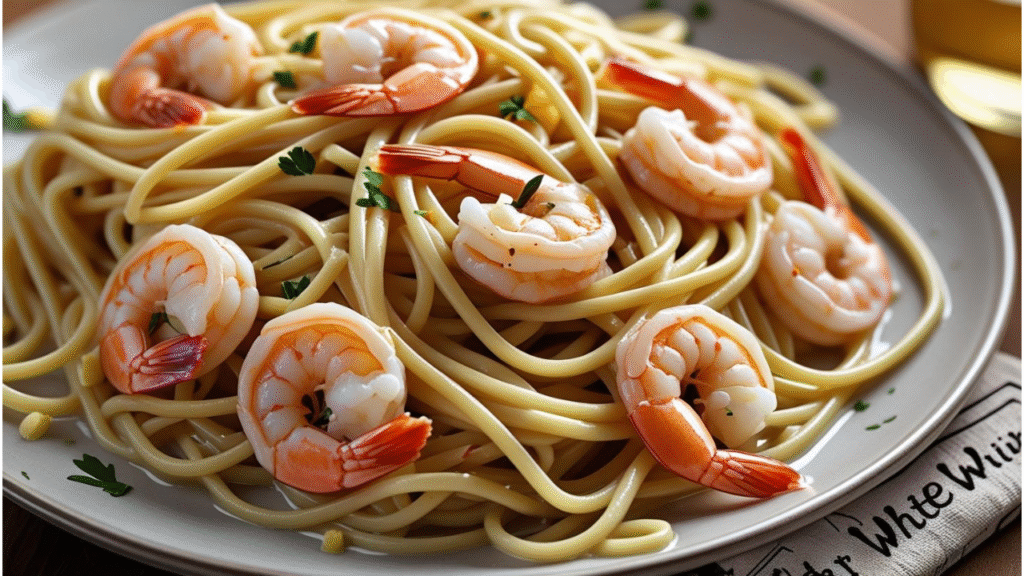Nothing tastes quite as delicious and yet requires so little as a good pasta dish. That’s what this Garlic Butter White WineshrimpLinguine is designed to combine everything you love about restaurant-style cuisine: succulent shrimp, rich garlic butter sauce and the depth of flavor from white wine–all in one easy-to-make dish.
This dish well suits the need of preparing dinner in a rush evening or taking out some romantic, elegant cuisine. With a total cooktime around 30 minutes, it’s a recipethat you’llfind yourself turning back to again and again.
In today’s article we’re going to cover how to make the best garlic butter shrimp linguine recipe with white wine; what items are used in place of those called for here if necessary; tips for that sauce; and how to save your leftovers safely.

Why Is Garlic Butter Shrimp Linguine So Popular?
Garlic Butter White Wine Shrimp Linguine Recipe
Ingredients
Equipment
Method
- Bring a large pot of salted water to a boil. Add linguine and cook according to package instructions (8–10 minutes). Reserve 1/4 cup pasta water before draining.
- In a large skillet, melt 2 tbsp butter with olive oil over medium heat. Add garlic and sauté for 1–2 minutes, until fragrant.
- Add shrimp to the pan in a single layer. Season with salt, pepper, and red pepper flakes. Cook 2 minutes per side or until pink and opaque. Remove shrimp and set aside.
- Pour white wine into the skillet, scraping up brown bits. Simmer for 3–4 minutes until reduced by half.
- Finish the Sauce
- Add remaining 1 tbsp butter and lemon juice. Optional: Add lemon zest for extra brightness. Adjust seasoning.
- Add cooked linguine and a splash of pasta water to the sauce. Stir to coat. Return shrimp to the pan and toss everything gently to combine.
- Plate the pasta and top with fresh parsley and Parmesan. Serve hot with lemon wedges or crusty bread.
Notes
- Use fresh garlic instead of pre-minced for better flavor.
- Don’t overcook shrimp – remove them as soon as they’re pink.
- White wine substitute: Use low-sodium chicken broth + splash of lemon juice.
- Add-ins: Try mushrooms, spinach, or zucchini for extra nutrition.
- Reserve pasta water to help emulsify and thicken the sauce.
What to Serve With:
- Simple green salad with lemon vinaigrette
- Garlic bread or crusty French baguette
- Grilled asparagus or green beans
- A glass of chilled white wine (optional)
Storage & Reheating:
- Refrigerate leftovers in an airtight container for up to 3 days.
- Reheat gently in a skillet over low-medium heat with a splash of broth or water. Avoid microwaving shrimp to prevent rubbery texture.
Dozens of shrimp pasta recipes can be found online, but this one stands out for its purity of taste and a depth reflected in the twice-cooked buttered shrimp.
Here’s what makes this combination a hit among fans:
Developing rich tastes also maintains health benefits. Add a touch of cold white wine and you have the perfect dish.
The ingredients are simple too
3.2 Balance of Proteins, Carbohydrates and Flavor
It can be easily changed to satisfy different tastes Buckwheat-style garlic buttered shrimp with fruit, baked bread or wine, red wine and other foods. What you want is a combination of novel flavors.
Ingredients You Need
- You will need the following ingredients before you begin:
- For the linguine:
- 8 ounces linguine (you can also use spaghetti or fettuccine)
- For the sauce and shrimp:
- 2 tablespoons olive oil
- 3 tablespoons unsalted butter (divided)
- 5 cloves garlic, minced fine
- 1 lb large shrimp, peeled and deveined
- 1/2 cup dry white wine (Sauvignon Blanc or Pinot Grigio recommended)
- Juice of half a lemon
- Salt and pepper to taste
- 1/4 teaspoon crushed red pepper flakes (optional, for mild heat
- 2 tablespoons fresh parsley, chopped
- Freshly grated Parmesan cheese (For garnish)
Optional: More Flavor
You can also add: Lemon zest, A splash of that French “pasta water” reserved before draining it
How to make garlic butter shrimp with white wine linguine
Step 1: Cook the Linguine
Fill a large pot of water, bring to the boil, and generously add salt. Put the linguini in and boil for about 8-10 minutes, or until soft when tested with a fork; constantly stir it while cooking. After turning off heat, turn the noodles into a bowl with olive oil and set aside half a cup of pasta water in case it is needed for gravy later on. Drain remaining liquids from noodles using colander for pasta as necessary briefing you on some portioning tips.
Step 2: Create the Garlic Butter Sauce Base
While the noodles are cooking, in a large skillet combine 2 tablespoons butter and 2 tablespoons olive oil on medium heat. Do not let the butter burn so when it starts to brown slightly add minced garlic and sauté for about one to two minutes until fragrant. Stir often in order not to scorch.
Step 3: Cook the Shrimp
Add the shrimp in a single layer and season with salt, pepper, and red pepper flakes. Be sure to sauté for about two minutes on each side until they turn pink and begin to become opaque.
When shrimp are done, remove them from the pan to a plate on which you have set them aside.
Step 4: Deglaze with White Wine
This step has you adding the white wine to the same skillet in which the shrimp was sautéed just now. Scrape up brown bits with a wooden spoon, then simmer for about three to four minutes until it reduces by half. This process intensifies the flavor and also removes all of the alcohol while keeping its complexity.
Step 5: Finish Your Sauce
Add the remaining tablespoon of butter and lemon juice from half a lemon. Taste the sauce and adjust seasoning with salt and pepper. At this stage, you can add a bit of lemon zest for extra brightness.
Step 6: Combine It All
Throw in the noodles from Step 1 and a splash of reserved pasta water into that pan where all these sauteed things are living – stir until it is evenly coated. Now back into this pan goes the shrimp: stir that until everything is combined and then heat for one to two minutes before turning off heat behind you.
Step 7: Serve
Serving the shrimp alongside the noodles, sprinkle fresh chopped parsley and grated Parmesan cheese on top. Serve hot with fresh lemon wedges as an accompaniment or crusty bread if you’re into that.
Chalo, simple aur clear banaata hoon, jo aap easily samajh jao — ye ek normal table format hai jo aap kisi bhi text editor ya spreadsheet mein copy-paste kar sakte ho:
Substitutions and Ingredient Alternatives
If you’re missing an ingredient, here are some smart substitutions you can use:
| Original Ingredient | Alternative Selection |
| Linguine, also known as angel hair pasta, fettuccine, or spaghetti | |
| White wine | Chicken broth with a dash of lemon juice |
| Plant-based butter or ghee | Butter |
| Olive oil | Avocado or canola oil |
| Thawed frozen shrimp or scallops | Fresh shrimp |
| Pecorino Romano or nutritional yeast (for dairy-free) | Parmesan cheese |
Professional advice for success

Dry sherry, not sweet – A dry Sherry provides acidity and depth without overwhelming the sauce.
Most such shrimp won’t taste good if overcooked – Once they have turned pink and curled (a little), take them out of the pan. Overcooked shrimp very soon become rubbery
Fresher garlic – Pre-minced garlic in jars regains nothing of the bite from freshly chopped cloves.
Use pasta water – A splash brings the sauce together beautifully and gives pasta an irresistibly silky texture.
Then use your own cheese grater – Pre-grated Parmesan often has anti-caking agents mixed in which don’t melt well.
What to Serve with Shrimp Linguini
The treat continues in this vein, adding a salad and some asparagus for a full meal.With a simple green salad that has been shrouded in lemon juice and drizzled with olive oil.Grilled asparagus or green beansGarlic bread in the style of a French baguette.
Apart from any dishes left over from the meal you will need to wash your hands thoroughly before working with raw meatA glass of white wine ( and other alcoholic beverages according to taste )
How to Store and Reheat
Storage
Leftovers can be refrigerated in an airtight container for up to three days. This is a really lovely dish freshly made and pretty tastey reheated.
Reheating
Gently reheat in a pan over low to medium heat. Add a little chicken broth or water to thin the sauce. Do not microwave as it can overcook the shrimp.
Frequently Asked Questions
Can I make this recipe without wine?
Yes. Replace the white white with the same amount of low-sodium chicken broth, and a splash of lemon juice to keep the acid in balance.
What kind of shrimp should I use?
Photo: Andrew Scrivani for The New York Times You’ll want big or even extra-large shrimp, peeled and deveined. You can also use frozen shrimp; simply thaw and pat them dry before cooking.
Can I use vegetables in this dish?
Absolutely. Top them with sautéed spinach, some cherry tomatoes, mushrooms, or even zucchini for an added nutritional or flavor boost.
Can this be made dairy-free?
Yes. Instead of butter, opt for a plant-based spread, and if you’re dairy free, skip the Parmesan or substitute a dairy-free alternative.
Final Thoughts
Garlic Butter White Wine Shrimp Linguine is one of those gourmet meals that you may think is just too hard to make; but I’m telling you, this recipe is easy and delicious! With standard pantry staples, fresh seafood and a bit of flair, you can produce a pasta you love just as well as what’s served at your favorite restaurant. Suitable for dinner parties, romance or special treat at home.
You make it once, and this one’s going to become a fixture in your rotation.
